![]()
![]()
![]()
Use LEFT and RIGHT arrow keys to navigate between flashcards;
Use UP and DOWN arrow keys to flip the card;
H to show hint;
A reads text to speech;
48 Cards in this Set
- Front
- Back
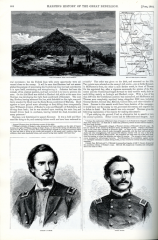
|
Alfred H. Guernsey and Henry M. Alden, Harper’s Pictorial History of the Civil War (1866) 1. Northern vision of the war. Encouraging men to enlist- orderly, dignified armies. Dignified portraits. How important resources were North- railroads=access to resources. Peaceful landscape scene. 2. Pictures could not stand alone, hard to read what’s going on/difficult to see relationship between images. Not bloody or violent. No slaves depicted. 3. Towns are all depicted from a hilltop or from the river, and appear defenseless, vulnerable. Handy for recruiting union soldiers unsure of war. |
|
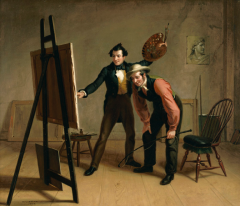
|
William Sidney Mount, The Painter’s Triumph, 1838 1. This artist only went to school for about a year, he felt it was more important to work from surroundings, not academic paintings. 2. Shows the ARTIST'S STUDIO, showing it as a workspace (canvases). The artist pointing to the easel, holding palette. 3. Other man is a farmer (horse whip/farmer's hat); something not previously seen. 4. In the back, there is a classical sculpture that mirrors the farmer's face. It is based off of sculpture of Apollo-something used to study the human form. -LITERALLY turning their back on academic painting. 5. Felt that appropriate subject matter for art is actually everyday life--art by the people, for the people. 6. This helped expand the audience for art, making it available to all. |
|

|
Richard Caton Woodville, War News from Mexico,1848 1. Patio outside hotel-reading lastest work in a newspaper. 2. Tension over disputed territory of Texas--will it be a slave state or free state? [it would be a slave state]. 3. All of the white men are surrounding the main figure, engaged. 4. In the bottom, black man and child can hear but cannot see or participate, this is a representation of black people's role in society at the time. 5. White woman in window, can hear but not see or participate, like black people. Also a social commentary of their roles. 6. This was seen as a way to normalize the status of these people. |
|
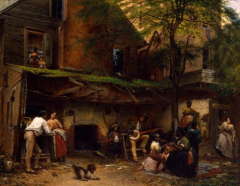
|
Eastman Johnson, Negro Life at the South,1850 1. Scene based off of a back alley in D.C. behind a slave quarters. 2. Shows a leisure moment: see a banjo player, people clapping, family playing and hanging out. 3. However, they are enjoying life while house is incredibly worn--peeling, roof about to collapse. 4. Can see a white woman (right) intruding on "black space." 5. Shows the secret life white people don't know about. Familial contact and community still exists in oppression. 6. POSSIBLE THEORIES: -Makes it seems like everything is "just fine", people don't need to change or fix anything for these people. -Suggests humanity of these enslaved people, possibly to help lead abolitionist activities. |
|
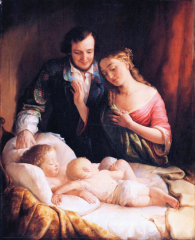
|
Lily Martin Spencer, Domestic Happiness, 1849 1. Domestic space from women's point of view. 2. Artist made the money to support family, husband stayed at home. 3. Baby looks cherubic-somewhat Christlike, alluding to the lamentation. 4. Sense of protection from parents: dad rests hand on baby's head; woman trying to prevent babies from waking up. 5. Shows a scene not accessible to the general public, so the viewer is allowed an invitation to see in. |
|

|
Mary Edmonia Lewis, Forever Free, 1867 1. Unconventional Emancipation Proclamation monument: "All are Forever Free." Proclamation did not abolish slavery but the monument is dedicated to Leonard Grimes, an abolitionist. 2. Depiction of Af. American man (hair) raising left arm with a broken shackle and a native american or white woman kneeling with a broken shackle on foot, praying. 3. Important b/c this is the first depiction of an Af. American man displayed as a powerful figure. However, woman is subservient. 4. This depiction of these gender roles depicts strength in black families. 5. Possibly representing different types of abolitionist fights: -Physical Fight: man is strong, physically breaking shackles. -Christian Woman's Group - took abolitionist causes along with woman's rights (=kneeling in prayer). 6. Both gesturing towards God, showing religion as a role in this effort. |
|
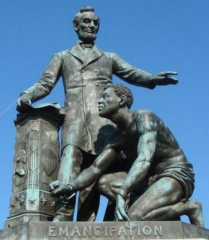
|
Thomas Ball, Freedman’s Memorial to Abraham Lincoln (Emancipation Monument),1876 1. Common depiction of Emancipation Proclamation. 2. Abe is a clothed, dominate figure. He is standing, looks commanding and is looking down on black man. 3. Black man is nude and subservient. Does not make eye contact with Abe or the viewer. Looks lost. 4. No text or voice to show context, Lincoln is responsible for freedom. 5. Reference to abolition but the visual language perpetuates racism and its hold on America. 6. Shown to broader public (in a park)-- important bc introduced slavery into public commemoration of civil war. |
|
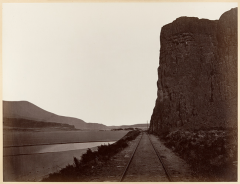
|
Carleton Watkins, Cape Horn near Celilo, 1867 1. Watkins incorporates RR in such a way that makes it seem a part of the landscape and composed like a painting. Landscape photo of RR cutting through rock faces. 2. Pic taken on the track, follows the natural lines in landscape. Typical pictures would depict the RR was detrimental to landscape, this shows that is can be a part of it. 3. Invites people to the Western landscape. 4. Commercial Work - Purchased by Oregon Company as a form of advertisement to use as good PR for RR's. |
|
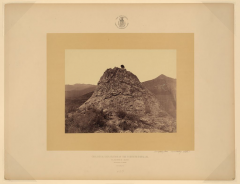
|
Timothy O’Sullivan, Hot Spring Cone, Provo Valley, Utah, 1869 1. A scientist poking his head inside the dome (had to look inside of it to observe details). 2. This showed landscape needed expertise to explore it. Shows nature as a specimen. 3. O' Sullivan composes dome as focal point - it obstructs the view to show that science is the only way to overcome it. 4. Artist allowed landscape to appear as strange as it would be for the expedition crew, not necessarily a place of wonder or tourism. |
|
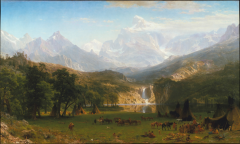
|
Albert Bierstadt, The Rocky Mountains, Lander’s Peak, 1863 1. Artist went out on his own and worked with surveys but did not work FOR them. He would sketch what he saw, come back, and paint in his studio. 2. Native Americans seen in landscape. Fire is out, they are packing up camp and on their way out. Landscape is for the taking. 3. Emphasis on wooded land and water, these are resources people would be concerned with out west. 4. Camera on tripod-he and his brothers were documenting the Native Americans. 5. Relationships between humanity and nature. |
|
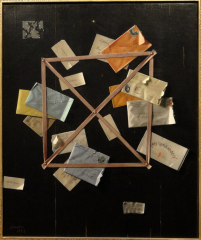
|
William Harnett, Mr. Hulings’ Rack Picture, 1888 1. Scraps of paper on a flat place of canvas; portraiture. 2. Hulings was a dry goods merchant: scraps are of a envelope, calling card, letters, newspaper clippings. 3. Things are addressed to his place of business but everything is from friends, not related to business, some are even from civil war. 4. Portrait not interested in physical aspect of Hulings but rather showing him as a friend, a businessman. It depicts his entire life instead of one composed moment. 5. This is Huling's "social" and "spiritual" self. This is how he see himself, not how others see him. 6. Strictly man-made objects; meditation on humanity. |
|
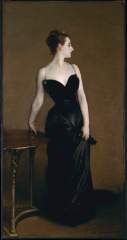
|
John Singer Sargent, Madame X (Madame Pierre Gautreau), 1883-1884 1. Woman posed, facing front but head to the side, away from viewer. Wearing a revealing dressing that was even more revealing in the original (one of the straps hanging down). 2. This painting was a display of sexuality and both the artist and person were ridiculed. Artist made name of painting anonymous because of controversy. 3. Woman in his social circle so he tried to paint with respect. 4. Allowed women to showcase their agency. Eschews Victorian ideas about femininity. |
|
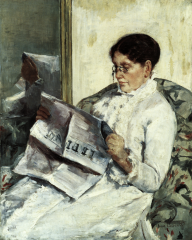
|
Mary Cassatt, Portrait of the Artist’s Mother Reading Le Figaro, 1878 1. Artist's mother in parlor/living room, reading Le Figaro, an important newspaper in France. 2. She is not represented in a domestic way but rather as an informed citizen. 3. Lack of shadows, the painting looks compressed/smushed but if you focus on the subject, it shows a deep sense of mental capacity. 4. Mirror reflects newspaper as the mother sees it, the mother's perspective shows how she is engaged with the paper. 5. Women are substantive human beings, not just objects of the "gaze". |
|
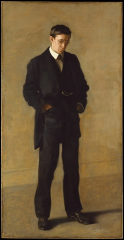
|
Thomas Eakins, The Thinker: Portrait of Louis N.Kenton, 1900 1. Portrait of artist's brother-in-law. 2. Portrait of Louis as a banker but not seen in professional or social role. 3. He is standing in a tan, interior space wearing a simple suit. Somewhat anonymous, you can't even see his eyes. 4. Shows him as a thinker and the dynamism of his mind especially through the erratic brushwork. 5. Emphasis on verticality of his body, acknowledgment of body. 6. Wanted to show the audience how important it is to understand how the body works inside and out and the relationship between body and mind. |
|
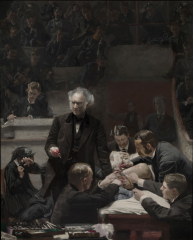
|
Thomas Eakins, The Gross Clinic (Portrait of Dr.Samuel D. Gross), 1875 1. Scientist and intellectual interest. Made painting for scientific exhibition, (1st World Fair in USA) 100 yeas of Philadelphia history and its contributions to science and medicine. 2. Gross contributed a lot; here, treats Osteomyelitis (bone infection) where you can just remove the piece of bone, saved lives. How is this a portraiture. 3. Dr. Gross in the context of surgery. @ Amphitheatre, everyone involved except for patient’s mother (required to be there). 4. Anesthesia developed. Holding incision. He is not performing but pauses to explain something to students, draws a relationship between surgeon and teacher. 5. Act of surgery, understood to be violent and brutal. Explores body and mind. 6. Upper register -> mind, light calling attention to his mind. Lower register -> body, where surgery is taking place. Artist as student. Requires skill and education to be a surgeon. 7. Medical people saw painting all in this way, but art committee rejected it. 8. Painting read as incredibly violent and bloody. Nudity of patient, now in surgical subject/ context. Medical building accepts it as a depiction of medicine. 9. Compared to Mr. Hulings’ Rack Pictures -> absent body. |
|
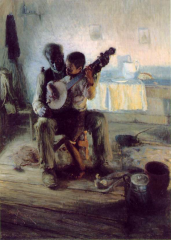
|
Henry Ossawa Tanner, The Banjo Lesson, 1893 1. One of the first Af. Am's in Pennsylvania School of Fine Arts - embraced education for himself and Af. Am's. 2. Af. Am Man & grandson; he is teaching him to play the banjo. This conveys the bond between them through making music. 3. Represented in a domestic interior, fireplace is casting warmth, soft brushwork. Somewhat impressionistic to show union and warmth. 4. Look as if they are melded into one figure; boy is standing between his legs, grandpa is support. 5. Responding to negative images of Af. Americans at the time: minstrel shows used actors in black face, often using banjos to perpetuate stereotypes. 6. Takes the negative stereotype of the banjo as a form of education, not a form of oppression. |
|
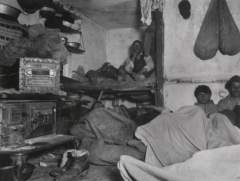
|
Jacob Riis, Five Cents a Spot for How the Other Half Lives (1890) 1. Cost 5 cents to stay at a shelter for the night. 2. When flash was invented, Riis popped into the tenements and took pictures unannounced. 3. Flash sounded like an explosion so people look confused/scared in picture bc they did not expect it. Captured negative emotion, natural and not composed/spontaneous. 4. Flash creates artificial and harsh shadows; depicts people as depraved to get people's attention. Setting is crowded, dirty, cramped, and unpleasant. 5. Eventually these photographs caught the attention of Teddy Roosevelt; he closed the worst tenements and enforced laws. 6. People though criminals are inherently bad, but Riis says its because of the environment they live in, by fundamentally changing this, less crime. Limitations, people needed to be inspired, but when economics come into play, not so much. Five cents to stay the night, not a hotel or permanent residence. |
|
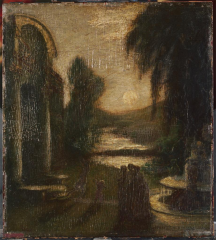
|
Albert Pinkham Ryder, The Temple of the Mind, before 1885 1. Imaginary landscape based off of "Fall of the House of Usher" by Poe. Haunted Palace in the story; three graces; splashing fountain. 2. Three graces (figures) are the finer aspects of the mind. Faun outmaneurved by the 3 graces = allusion to classical ambiguity. 3. Sun descending/night falling represents mystery overcoming clarity. Painting considered a nocturne and this alludes to the unconscious mind, a mind haunted by phantoms. 4. Painting was a reaction of order and homogenization of industry. 5. Used experimental painting techniques; color cast gives the painting an ominous and mysterious feeling. Paint is so thick that it is cracking in areas. Harsh brushwork, all of these used as stream of consciousness techniques. |
|
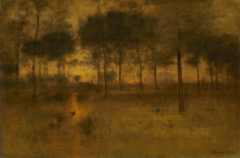
|
George Inness, The Home of the Heron,1893
1. Landscape created around Tampa, Fl. Focus is on heron's home rather than the heron itself. 2. Brushwork is soft and fuzzy; painting is split down the middle using a grid that is like the exoskeleton of the landscape. (geometry an important theme to Inness). 3. Painting looks somewhat like an x-ray due to it's brushwork and brown cast. 4. Inness consider himself a metaphysician and was interested in the broader world; felt that the divine could be found in the forms and colors of nature. |
|
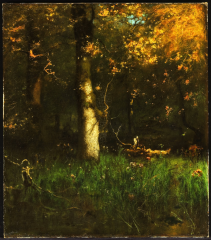
|
George Inness, Home of the Heron, 1891 1. Vibrant, more depth of color-lucious grass, fiery leaves, illuminated tree, blue sky. Heron is picture tiny and not the focus. 2. Interested in vertically & geometric. 3. Color is intentional, symbolic: red=love to God; blue=divine; yellow=love of man. All of these elements work together to create warmth and comfort for the heron. |
|
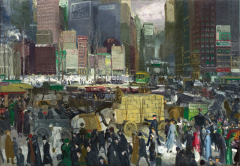
|
George Bellows, New York, 1911 1. Total immersion in chaos of the time. Sense of movement and streets. Busy intersection, what it feels like and looks like. 2. Subject matter and style act as a way for the artist to embrace the grittiness of city dwelling. 3. Quick brushwork makes it difficult to differentiate between buildings and people, furthering his idea of immersion into city life. 4. Not escapist Ashcan school with Henri, Durand, Luks, Sloan, etc. Compare this painting with Durand’s “Landscape: Creek and Rocks.” |
|
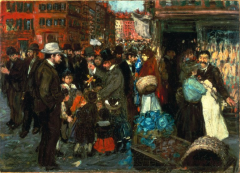
|
George Luks, Hester Street, 1905 1. Revision of Genre practice (everyday life). The theatre of the street. See to be seen, Like Cassatt’s Theatre painting. 2. Streets = people-izer downtown. Mainly ethnic communities. 3. Interactions in the street. Harmonious, with equity. Streets are the great equalizer. 4. Not showing the people degraded like Jacob Riis did. |
|
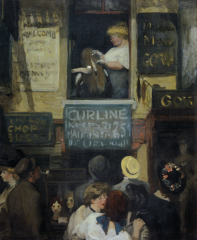
|
John Sloan, Hairdresser’s Window, 1907 1. Illustrator’s sensibility. Interest in/distrust of vision. 2. Irish immigrant dying her hair. Looking and not looking. ^ Also compare to Cassatt’s “In the Loge” about people watching other people. |
|
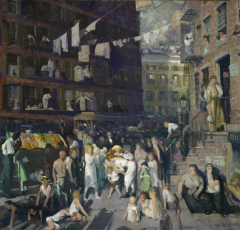
|
George Bellows, Cliff Dwellers, 1913 1. Subject matter and style act as a way for the artist to embrace the grittiness of city dwelling. 2. Quick brushwork makes it difficult to differentiate between buildings and people, furthering his idea of immersion into city life. 3. Same image as his illustration “Why don’t They go to the Country for a Vacation?” The title of the illustration calls out condescension and naivity of upper class. The painting was for a different audience. 4. “Cliff Dwellers” would be seen by the upper class, so he made it more sympathetic to the plight of the tenement dwellers. |
|
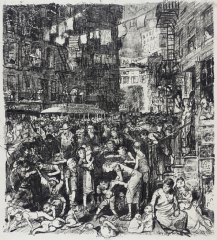
|
George Bellows, “Why don’t they go to the country for a vacation?,” The Masses, August 1913 1. Embrace of the gritty realities of the modern city, inspire sympathies. Bring all classes in fine arts Worked for the masses. 2. Compared to West’s Wolfe. 3. The Masses- socialist journal. 4. Title of piece--POV of wealthy inhabitantsHow dirty the scene is. 5. Dada and Stieglitz circle focused on industry of the city (not people). Dada questioned art. Stieglitz -> looking @ NY in order to assert photography as an art form. |
|
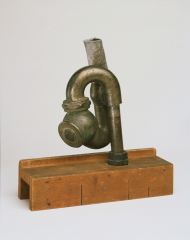
|
Baroness Elsa von Freytag-Loringhoven and Morton Schamberg, God, 1917 1. A standard sink pipe, attached to a wooden block. 2. Appraisal of American industry & infrastructure. It's put on a pedestal to aggrandize it. Rapid industrialization is the focal point in the period. 3. Update idea of modern art for a modern age; most Dada artist saw industry as one of the defining features of America and felt it should be represented in art, not landscape imagery that was popular in America at the time. |
|
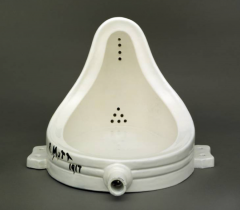
|
Marcel Duchamp, Fountain, [1917] 1. Reproduction; a porcelain urinal put on its back, signature on side of "R. Mutt", and titled "Fountain." 2. Meant to be ironic, it is not a fountain nor is the work of R. Mutt. It was meant to challenge high art (reference to Fountain of Bernini). The artist name was a mix of several different sources. 3. Object was bought in a plumbing shop; playing with ideas of titling, signatures, these lend meaning to a work of art but he wanted to confused viewers. This artwork is undermining all of these "conventions" of art. 4. Challenging the idea of what makes art. Is it the change of context? The original was made to be functional for body functions. This new context is created with artistic conventions. |
|
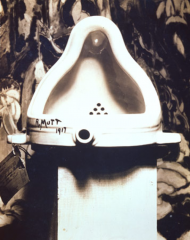
|
Alfred Stieglitz, Fountain, 1917 1. Duchamp's fountain on a pedestal, in front of a Stieglitz circle painting. Use of dramatic lighting creating harsh shadows and it is off-centered. 2. Fountain reinscribed as an aesthetic object. Painting as background shows something that is considered art in juxapostiton of the urinal. 3. Raised the questions of what should are be? Should it be beautiful or challenging? Should it be conceptual? |
|
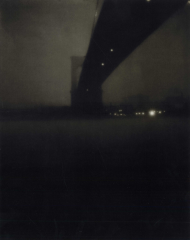
|
Edward Steichen, Brooklyn Bridge, 1903 1. Black underside of the Brooklyn Bridge over the Hudson River at night. Foggy and dark nocturne with little light. 2. Sense of elegance in shape of the form, it frames the sky and city. 3. Reclaiming photography as art as it was previously seen as documentation. 4. No interest in the industrial side of things but rather borrowed ideas from landscape paintings such as to show beauty, represent atmospheric weather, shade, ranges of blacks and contrast. 5. Camera is not an apparatus for art but rather a tool to help artist create idea. 6. Often added elements of handmade/chemical processes to make one-of-a-kind works. |
|
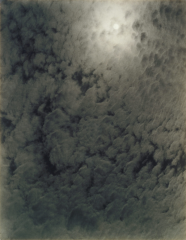
|
Alfred Stieglitz, Equivalent, 1926 1. Photograph of the sky, sun, and clouds. 1 in a series of 400 pictures of clouds over time. 2. Picture meant to be read like a modern painting; tried to have an emphasis on abstraction to be in dialogue with modern art. 3. FORM OVER SUBJECT MATTER. All different but all clouds; discusses the formal qualities rather than clouds or subject. 4. Used clouds to represent 40 years of learning without the distraction of subject: composition, cropping, framing, etc. 5. Photography not manipulated; not an allusion to landscape painting. |
|
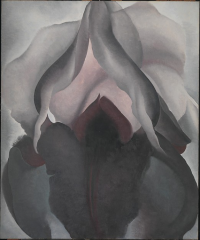
|
Georgia O’Keeffe, Black Iris, 1926 1. Inside of the Black Iris flower; shades of black, grey, and pink abstracted, billowing forms. 2. Magnified perspective of the flower; allows us to see flower from a different perspective in a way we don't typically see them. She likes to paint the overlooked. 3. Zooms in on these details to make people take a minute in life and think about the little things. Exploration of sight and perception. 4. Black Iris is only available for a short time; she is documenting it. Flowers are represented in most perfect state. 5. Wanted to define a modern role for painting; instead of a quick photo, these paintings took time, thought, and attention to detail. This is also seen in the emphasis on color, something not seen in photography. 6. People often thought her work was about vaginas but it actually never was. |
|

|
Arthur Dove, Fog Horns, 1929 1. Three large, red concentric circles and organic forms and shapes of different gradients of color. 2. Representation of a foghorn; ship not seen. Shows sounds with concentric circles, slightly changing color, showing the spread of sound like an echo. 3. Using an abstract language to communicate noises. 4. Organic forms undulate with the reverberation of sound over the blue water. |
|
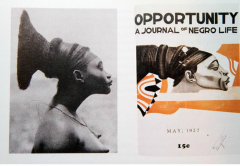
|
Aaron Douglas, [cover of Opportunity], May 1927 1. Transformed Sprecht’s photographed scientific project (race science). He (Sprecht) framed them as different and lesser than white people. 2. No individuality because faces were in profile. See her (the subject) as different and lesser, because of her face, hair, breast. This skewed views toward Africans. 3. Douglass exaggerates features, elongates makes it appear that she is “moving forward” cuts off her body for respect, draws attention to her expression and conviction. 4. Takes her away from natural landscape into abstract forms/ shapes -> African textiles. 5. Looks @ Africa in general, monolithic vision, still has pride in it. |
|
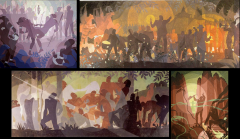
|
Aaron Douglas, Aspects of Negro Life, 1934 * The Negro in an African Setting (silhouettes dancing in a circle, resemble african sculptures) * From Slavery through Reconstruction (foreground- picking cotton, background- city scape. Suggests economic opportunities are in the north) * An Idyll of the Deep South (working the land, musician at the center) * Song of the Towers (musician breaks apart towers, viewers can see statue of liberty) 1. Site specific. NY public library in Harlem. Commissioned by federal government (The New Deal) for the community in Harlem. 2. Reframing history. Past in Africa and future in the North. Draws upon monolithic view of Africa. 3. Example include, generic sculpture, concentric circles, musician, difference between foreground and background -> Northern buildings = economic opportunity, jazz musician, circles emanates, statue of liberty. 4. All pieces are somewhat literal. Drawing upon geometric idea, silhouettes ideas as abstract as Dove’s work but for strategic political purposes. 5. Constructing communal vision of history toward future. Circles emanates = culture @ the center of African-American life. |
|
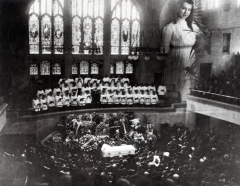
|
James VanDer Zee, The Funeral of Blanche Powell, Abyssinian Baptist Church, 1926 1. Puts out his experience of Harlem, a site of glamour and relationships. 2. Portrait floating, photomontage (destroys the veil). Blanche Powell -> father was important figure. 3. Shows us the way in which the people saw, who loved and saw her. Get sense of her life/ death. 4. As invested as Stieglitz in having photography as art. 5. Veil preferences how people see you vs how you see yourself |
|
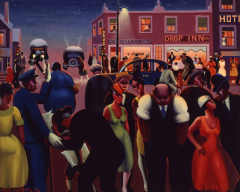
|
Archibald Motley, Jr., Black Belt, 1934. 1. Made Genre paintings. 2. Douglass was interested in Africa as the historical and cultural origins where Motley Jr was interested in Africa in the present. 3. Street scene in Chicago. As a site of community and pride, lively scenes. Almost as though street is a night club. Thriving, dynamic, active scene. 4. Motley Jr associates African Americas with urban North with modernity and with future instead of rural south. 5. Rhythm to color palette = jazz. |
|
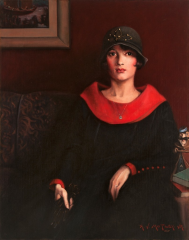
|
Archibald Motley, Jr. The Octoroon Girl, 1925. 1. In the image a graceful young woman with dark hair, dark eyes and light skin sits on a sofa while leaning against a warm red wall. She wears a black velvet dress, a hat and a gold necklace. Holds leather gloves. All of these suggest elegance and higher class. 2. Demonstrates conformity to white aesthetic ideals. Meant to be a symbol of social, racial, and economic progress. 3. even though the octoroon woman is part African American, she clearly does not fit the stereotype of being poor and uneducated. 4. He requests that white viewers look beyond the genetic indicators of her race and see only the way she acts now—distinguished, poised and with dignity. |
|
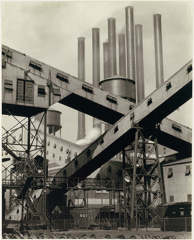
|
Charles Sheeler, Criss-Crossed Conveyors, River Rouge Plant, Ford Motor Company,1927 [N.W. Ayers for the Ford Corporation, “By Their Works YeShall Know Them” (advertisement), Vanity Fair, Feb. 1928] 1. Photograph of machinery of River Rogue Plant in Detroit. This is the plants that produced Ford Cars. Detroit was the center of the Auto Industry. 2. Sheeler was commissioned by an agency to photograph this plant. This factory was innovative bc it could transform raw materials to finished product (integrated, self-sufficient system). 3. Interest was in infrastructure of factory that made it work. It was unmanipulated and taken as he saw it. There was an emphasis on how shape and composition came together and he used formal qualities similar to painting. 4. Shows company as a powerhouse; TEXT compares it to the Senate and etc. "America's Mecca" compares it to religion; suggesting Ford is the prophet for the New Age. Photograph coincides with text, as the viewer in looking up at the factory in reverence. 5. Ayers Agency contacted Sheeler bc he was known for his avant garde work; they wanted him to create a modern depiction, showing the integration. Needed work so incredibly modern to convey the modernity of the factory. |
|
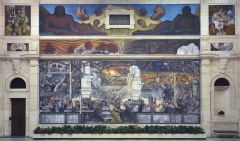
|
Diego Rivera, Detroit Industry, 1932 1. Depiction of the River Rogue Plant. Showsus inside of the factory; both the positive and negative aspects of industry. 2. Very busy, an emphasis on the workers/they occupy the lower registers. 3. Interior view, lots of machinery but shows that people are just as important as the machines. It is orderly and organized; equalizing the people and machines. Workers drive industry. 4. However machines look somewhat large and oppressive, possibly alluding to the dangers of industry as Deigo was a known socialist despite being commissioned to create this piece. 5. In context (with smaller panels): Diego inserts concerns about industry; a baby is being vaccinated BUT then scientists are working on developing a poisonous gas. 6. Challenging the idea that the River Rogue is a mecca but rather a factory run by every day people. |
|

|
Stuart Davis, Lucky Strike, 1921 2. Focused on relationships b/t forms; thought painting shouldn't be emotional but used to copy the aesthetics in life. 3. Very geometric and straightfoward; he felt that ads were deceptive and wanted to make work that could be authentic, basic, and effective. |
|

|
Edward Hopper, Nighthawks,1942 1. Figures in a diner at night, viewer is looking in from a distance. 3. Not one person matches their gaze with another. Physical proximity, but emotional distance by the modern city. 4. Coffee urns are close, but not touching. Everyone is together but alone. Emotional impact of corporate culture. |
|
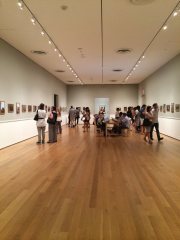
|
Jacob Lawrence, The Migration Series, 1940-41 1. Artist grew up during the harlem renaissance and was influenced by it. Created works about prominent African Americans. Yet, in this piece he focused on the collective movement of a group of people. 2. 1920-30’s was the black migration from the south to the north. This migration, viewed in relation to the Transatlantic Slave Trade is seen as voluntary (harlem r.) vs involuntary (transatlantic st.), respectively. 3. Part of a 60 part series. Depicts things such as the lack of individuality in an effort to emphasize the quantity of individuals, ambiguity of the destinations, loss of work as a reason to the emigration, lynching as a reason for emigration, better opportunities elsewhere including better living, food and education. 4. Also notes the dangers of the destination (northern cities) such as disease, competition for housing, and race riots. 5. Addresses history is popular terms; drew on oral tradition and the piece itself propels you to migrate through the gallery. |
|
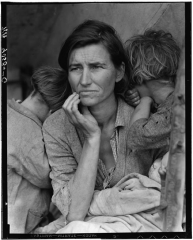
|
Dorothea Lange, Migrant Mother, 1936 1. A portrait of a mother looking off into the distance, distraught but strong. 3 of her children cower into her, looking to her for support and guidance. They are dirty and hungry. 2. Picture taken during Great Depression; photo is famous bc of its use of composition and capturing the emotion of the moment. 3. Important bc photographs would be sent back to D.C. to raise awareness about the pea worker's plight and to show Americans what the Great Depression was like for other people. Used as documentation but humanize the Great Depression. 4. Showing art in a role of social change; people began to donate food to these workers. |
|
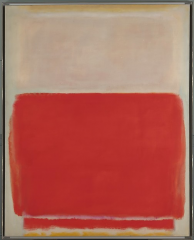
|
Mark Rothko, No.3, 1953 1. Red rectangle, soft edges overlayed on a grungey beige background. 2. Flat surface with rough brushwork and flat forms; everything is 2D with no use of lighting or delineation of perspective. 3. Appears to be many layers of color bleeding through; hidden red squares are seeping through the beige at the top of the painting. 4. No illustrative depth but depth with layers. 5. This abstraction was the reaction against the idea that art has to be political or meaningful. They are letting the painting be a painting, without manipulation. |
|
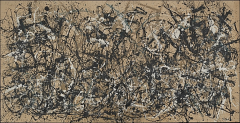
|
Jackson Pollock, Autumn Rhythm (Number 30),1950 1. Large-scale drip painting, various splatters and splotches of different kinds of paints and materials. So large, canvas placed on floor, works his way around it. 2. Pollock usually has a general notion of what he wants to express. Usually flings paint, lets painting have a life of its own. Typically considers nothing a mistake and never uses sketches or prep work. 3. Rhythmic strokes, strategy behind placement. 4. Psychological aspects to painting, sense of what he is all about and it is a representation of himself. 5. A record/index of actions used to create them and the mental machination of these decisions--essentially a record of the mind. |
|
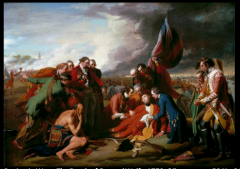
|
Benjamin West, The Death of General Wolfe, 1770 2. West looks @ world around him. Sees heroic suffering in the present moment. 3. Battle of Quebec. British wins Quebec, successful for Wolfe -> reputation rises to the British Empire. Multiple moments collapse. I 4. Image of The Lamentation. Flag as the cross. Four or five people when he dies, the others paid to be depicted -> these people were to the Empire. 5. Native American registers painting in the NW. Colonies belong to the British Empire. The king ordered a copy. Made as print and ceramics. |
|
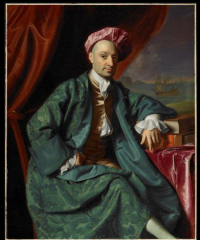
|
John Singleton Copley, Nicholas Boylston, 1767 1. He would sit with clients on multiple times for hours. Increased sense of 3D and used objects to depict people's roles and important traits they wanted to highlight. Often these were constructed ideas. 2. Books -> education. Ship in the background, shows role as a merchant. Clothes are exotic, trade of ideas, Indian clothes; bayan, hat -> relaxed whereas in public it would be a powdered wig. 3. Not meant to be seen by the public. Only family and colleges would view him -> wealth, and has time to have leisure time. |
|

|
Asher B. Durand, Landscape: Creek and Rocks, 1850s 1. Seems as a substitute for nature. Painting??? NY already (developed?) and first? Nature goes to you if you can. Spiritual break. |

